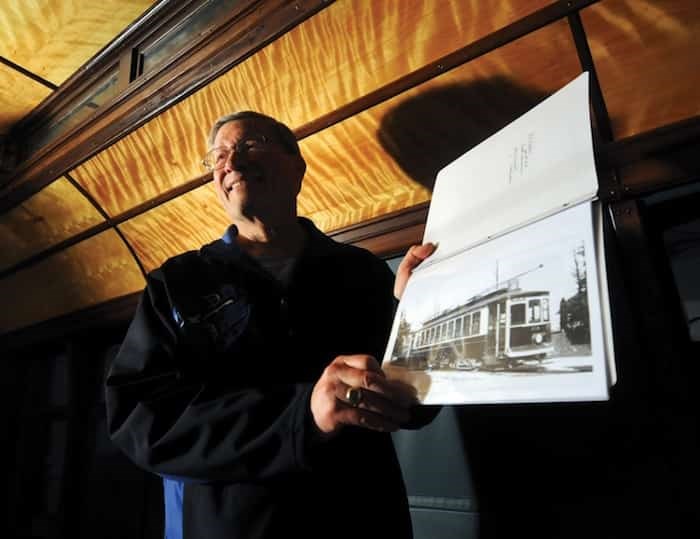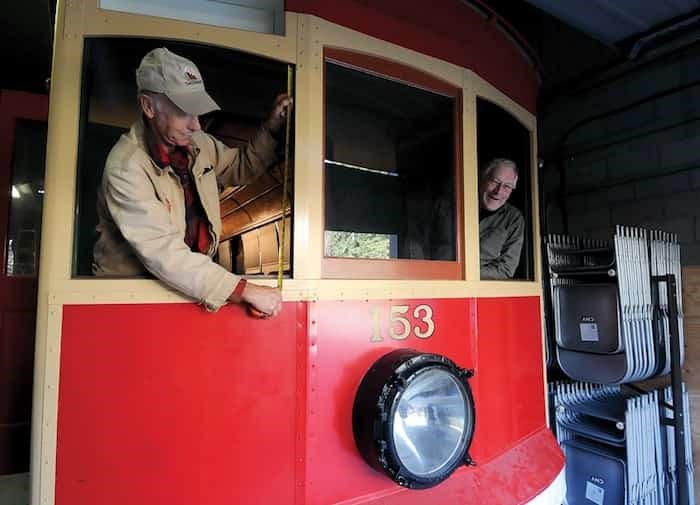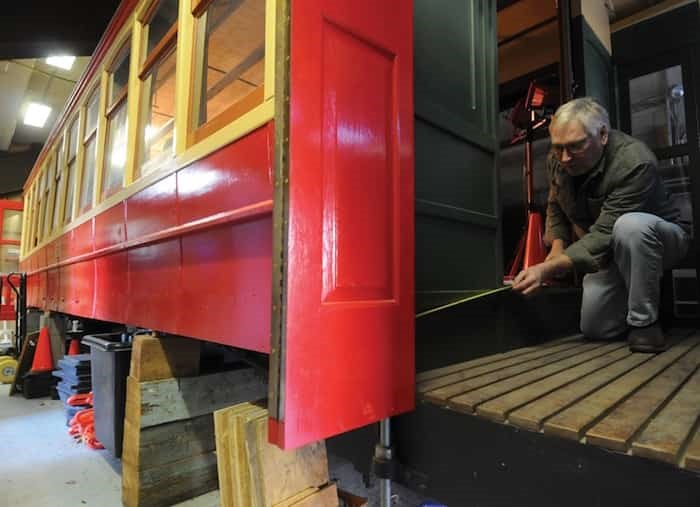 Don Evans discusses the restoration of the Lonsdale streetcar in preparation for permanent installation in the new museum coming to the Lower Lonsdale neighbourhood. photo Mike Wakefield, North Shore News
Don Evans discusses the restoration of the Lonsdale streetcar in preparation for permanent installation in the new museum coming to the Lower Lonsdale neighbourhood. photo Mike Wakefield, North Shore News
Editor's note: This story has been modified to omit an upcoming event which is closed to the public.
Glance beneath the bleachers at Fen Burdett Stadium and a century slips away.
North Vancouver’s 111-year-old streetcar, once preserved only in black and white pictures, is now resplendent in candy-apple red as restoration work nears completion.
Before vaping, dabbing, the abolition of the death penalty, the creation of the Canadian flag or the introduction of the microwave oven, Streetcar No.153 zoomed up and down Lonsdale Avenue, literally electrifying the community, notes Don Evans, chairman of the West Coast Railway Association.
“North Vancouver was in the dark,” Evans explains.
The generating plant that powered North Vancouver’s three streetcars – one to Lynn Valley, one to Capilano, and one straight up Lonsdale – effectively extinguished the gas lamp-era and illuminated North Vancouver in 1906.
North Vancouver had been a “poor cousin to Vancouver” in those early days, Evans says. “Hard to get to and not much here.”
But the streetcar was transformative.
At the dawn of the 20th century, ferry passengers arrived in Lower Lonsdale to discover a “little Siberia of bush,” according to local historian Shervin Shahriari.
Lonsdale Avenue was barely wide enough for horse and buggy traffic and halted at Eighth Avenue. The advent of the streetcar led to a widening of the road and opened up opportunities for mill workers and shipbuilders who were suddenly able to buy property in Central Lonsdale or Lynn Valley and take the streetcar to work.
And while the first streetcars occasionally hopped the dock and landed in the drink, the city’s second crop of streetcars, built by the John Stephenson Company of New Jersey, managed to stay on dry land.
Evans, a Central Lonsdale resident and lifelong “train guy,” has been prepping Streetcar No.153 for its position of honour in North Vancouver’s forthcoming West Esplanade museum.
 Dave Walmsley and Blaine Thompson lean out the windows of Streetcar No. 153, which first hit Lonsdale Avenue 111 years ago. – photo Mike Wakefield, North Shore News
Dave Walmsley and Blaine Thompson lean out the windows of Streetcar No. 153, which first hit Lonsdale Avenue 111 years ago. – photo Mike Wakefield, North Shore News
The work is more a re-creation than a restoration of the 1908 streetcar, Evans says.
Decommissioned in 1947, the car served as a bunkhouse, a restaurant, and a Langley chicken coop.
“It really, after the chicken coop, wasn’t salvageable,” Evans says. “All the mechanical stuff underneath was long gone.”
But Evans, Dave Walmsley and Blaine Thompson have set to work making the last remaining North Vancouver streetcar as authentic as possible. They’ll re-install bench seats with wicker backs, add a string of Edison bulbs, add controls to the motor man’s end and top it off with a trolley pole on the roof.
One of the challenges in the streetcar’s recreation was building the wheel sets, a task which fell to car rebuilder and welder Walmsley.
“Don comes to me with this project and says: ‘David, can you do this?’” Walmsley says. “I don’t know if I can, but I know I can try.”
There was no way to get the original trucks but there was a set from Belgium that was close enough to work with, Walmsley says.
“It’s a Meccano set,” he says. “The parts are from different boxes. We’ll pull them together.”
The work was “basic stuff,” Walmsley says. “Like changing a tire on your car.”
The basic stuff also involved cutting the streetcar’s old traction motors, sandblasting “right down to white metal,” before adding primer and paint.
“We took ugly and turned it into beautiful.”
Working on the century-old streetcar is a pleasure, Walmsley says.
“Modern stuff is all plastic,” he says.
“Stainless steel and plastic,” Evans agrees.
“This is a time capsule,” Walmsley continues. “Inside, outside, the whole experience is a time capsule.”
 The streetcar is set to be outfitted with new custom wheels, allowing it to sit on a piece of track in the new North Vancouver museum. – photo Mike Wakefield, North Shore News
The streetcar is set to be outfitted with new custom wheels, allowing it to sit on a piece of track in the new North Vancouver museum. – photo Mike Wakefield, North Shore News
Following what Evans calls some “jiggery pokery,” the 39-foot-long streetcar will be shifted out of Fen Burdett Stadium, manoeuvred past some tricky slopes in Mahon Park, and loaded onto a truck to be taken to Lower Lonsdale in time for the museum’s 2020 opening. The move will free up the spot behind the bleachers, Evans notes.
“I think the city works guys are looking forward to getting their space back.”



